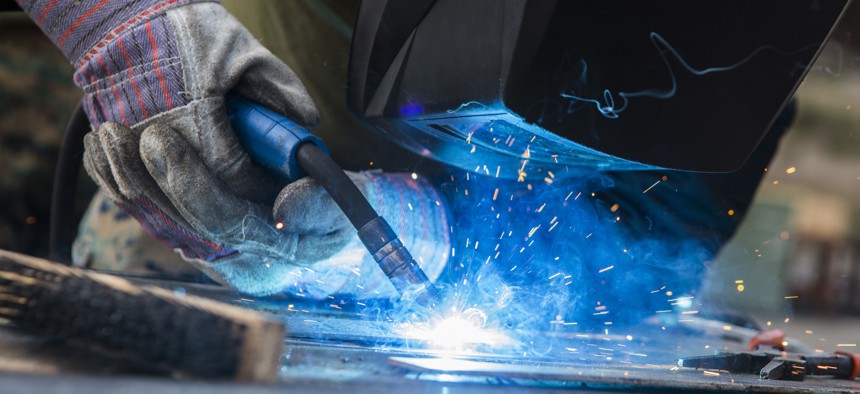
U.S. Marine Lance Cpl. Alante Pierce, a metal worker with 7th Engineer Support Battalion, 1st Marine Logistics Group, uses a mig welder to connect two pieces of metal at Camp Pendleton, Calif., Jan. 30, 2018 U.S. Marine Corps / Lance Cpl. Joseph Sorci
How Much Do America’s Arms Makers Depend on Foreign Metal? No One Seems to Know
Certainly, no one seemed concerned about it until Trump’s tariffs sent them scrambling to find out.
No one knows how the U.S. military and its weapons suppliers will be affected by President Trump’s surprise tariffs on imported steel and aluminum, because no one seems to know how much foreign metal is in America’s weapons.
“I’ve asked because I’m interested,” Lockheed Martin CFO Bruce Tanner said March 5.
Defense executives like Tanner have worked for decades to craft to global supply chains and an industrial base that is intertwined with key allies. But with the approach of these unexpected tariffs, which are forecast to hurt American companies from beer brewers to automakers, numerous interviews and conversations with executives, employees, and industrial base experts indicate that the defense industry doesn’t know its own exposure.
And if the Pentagon does, it’s not saying. Speaking alongside representatives from the U.K., Canada, and Australia on Friday at the Center for Strategic and International Studies, Jerry McGinn, the principal deputy director of the Office of Manufacturing and Industrial Base Policy at the Pentagon, said the Pentagon provided “input on DoD demand” to a Commerce Department investigation, but declined to say how much foreign steel and aluminum was used in U.S. weapons.
“We look at materials and metals in our industrial base analysis all the time to understand [and] maintain that we have enough to support our major programs and systems,” McGinn said.
Trump justified the protectionist measures under international trade law by saying they were necessary for national security.
“DoD does not believe that the findings in the reports impact the ability of DoD programs to acquire the steel·or aluminum necessary to meet national defense requirements,” Defense Secretary James Mattis wrote in a letter to Commerce Department Secretary Wilbur Ross.
But the Aerospace Industries Association — which represents major defense firms — has voiced a full-throated opposition to the tariffs. “Our industry employs 2.4 million people and produced a trade surplus of $86 billion last year,” Eric Fanning, AIA’s president and CEO, said in a statement. “Tariffs on aluminum and steel would jeopardize that surplus and put those jobs at risk.” The tax on aluminum alone “would create almost $2 billion in unnecessary costs to U.S. manufacturing,” Fanning said.
For Tanner’s Lockheed, the big question is how the aluminum tariffs could affect the price of the F-35 Joint Strike Fighter, an expensive plane with a sprawling supply chain that touches four continents. Much of the plane’s aluminum is forged by U.S-based Alcoa, but some comes from Canada, America’s No. 1 foreign supplier of the metal. An October 2017 report posted on a Lockheed-run F-35 website says Canadian companies have received near $5.5 million in contracts between 2009 and 2017 for “Alumina and aluminum production and processing.”
Tanner says Lockheed uses more aluminum than steel on its aircraft projects, which in addition to the F-35, include the C-130 cargo plane, and F-16 fighter. And the F-35 uses more titanium than aluminum and steel, he said.
Lockheed has aluminum purchasing agreements in place for the next three years, Tanner said.
“We negotiate long-term purchase agreements,” he said. “In the case of F-35, we’re already negotiated out until 2021. There’s no impact, at least, until post-2021 sort of no matter what happens near-term. It affects our suppliers, but it doesn’t affect the pricing that we’ve negotiated for our supply chain.”
Update: Lockheed Martin does "not expect these tariffs to have a significant direct impact" on its programs "because we procure most of our materials through long-term agreements," Bill Phelps, a company spokesman said in an email Monday. "We will, however, continue to evaluate the impact on our supply chain, which could be more directly and immediately affected — potentially driving up costs and leading to delays in delivery of these materials for our products. We’re encouraged that the president’s proclamation excludes Canada, which is a key ally and plays a critical role in support of U.S. national security programs."
Still, investors fear that those suppliers will pass any increased cost back to Lockheed further down the road. That could end or even reverse a years-long trend of dropping F-35 price tags.
“If the Trump administration implements the steel and aluminum tariffs,” Roman Schweizer, an aerospace and defense analyst with Cowen and Company, wrote in a March 6 note to investors, “we find it difficult to imagine that it would not have an impact with major allies such as Canada, Germany, Japan and South Korea.”
Analysts with Citi, however, said the tariffs’ effect would be muted by exclusion clauses for Canada, Mexico and possibly others; an ongoing trend of using less steel and aluminum in aerospace and defense products; and long-term supply agreements like the ones Tanner described.
And some defense products are made solely with U.S. steel anyway. Lockheed’s shipbuilding division, which makes Littoral Combat Ships for the U.S. Navy, buys its steel from two American suppliers, said Dale Bennett, executive vice president of Lockheed’s Rotary and Mission Systems division. That division includes shipbuilding, Sikorsky helicopters, and high-tech missile defense radars.
“That program’s pretty good,” he said of the Littoral Combat Ship. “I have to do a lot of other analysis across the portfolio.”
